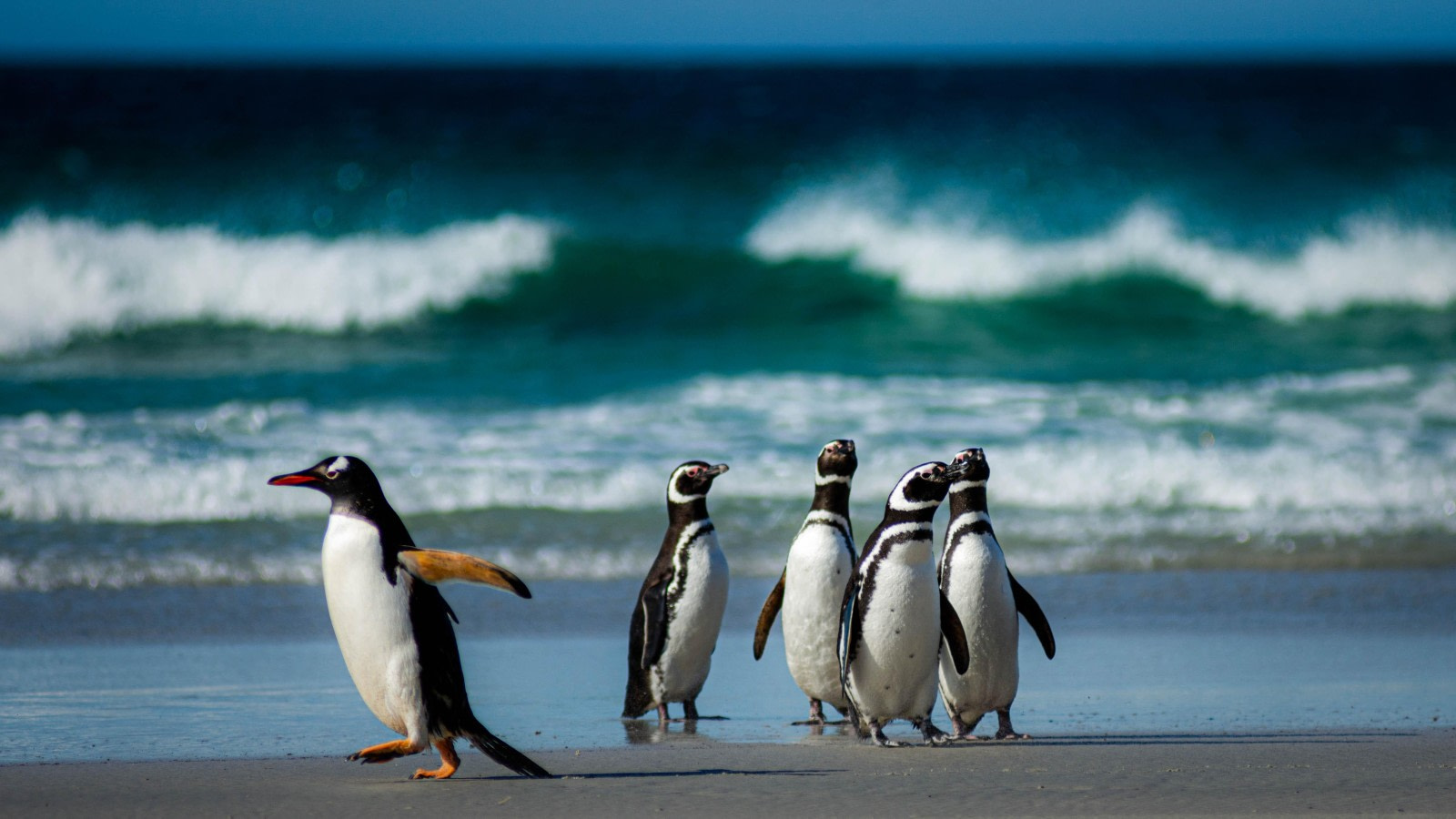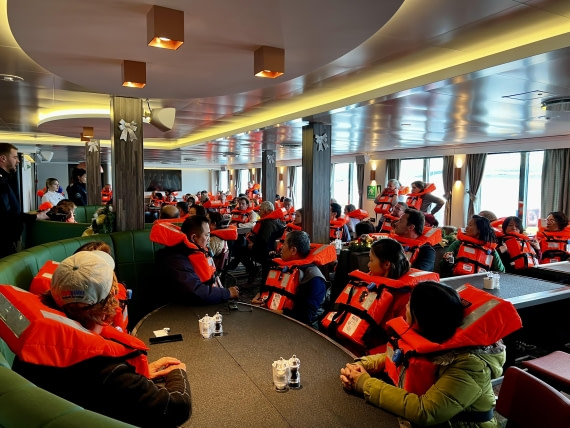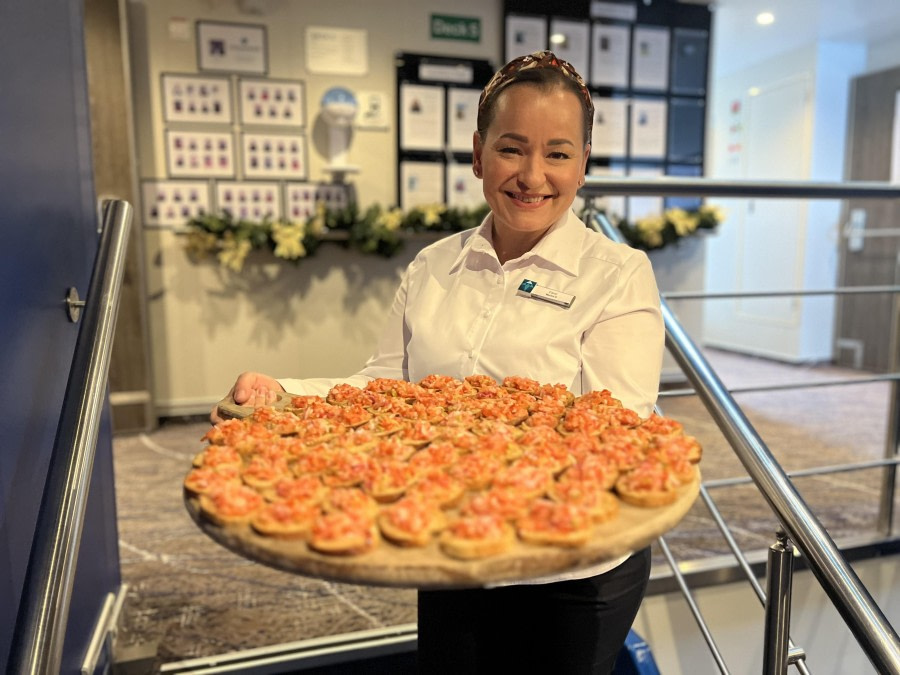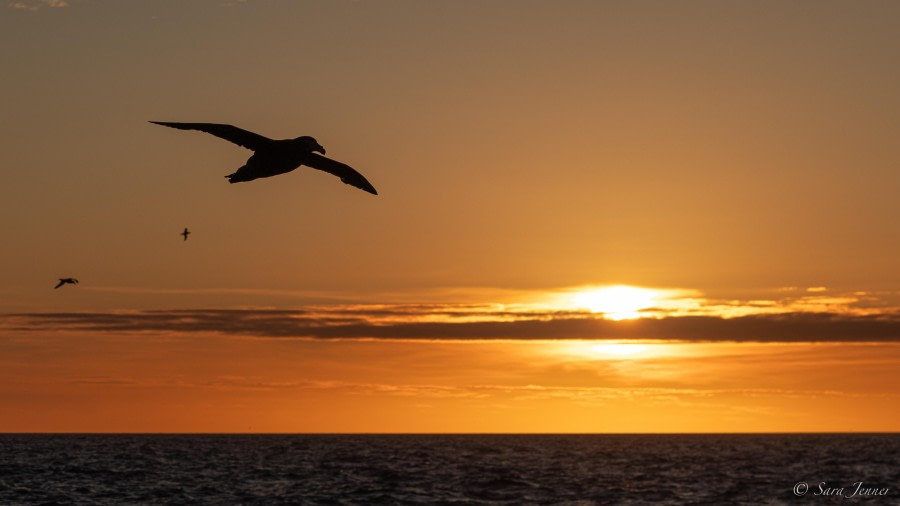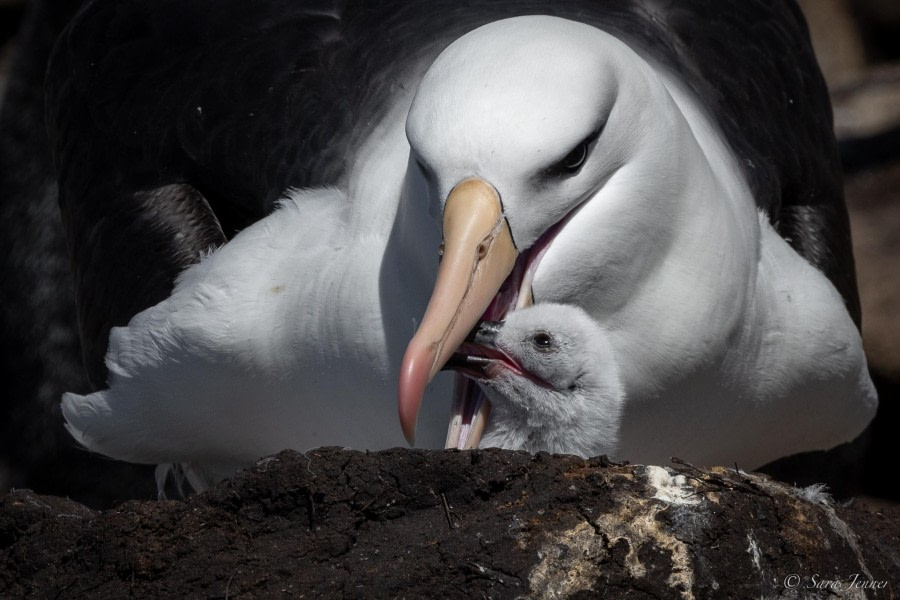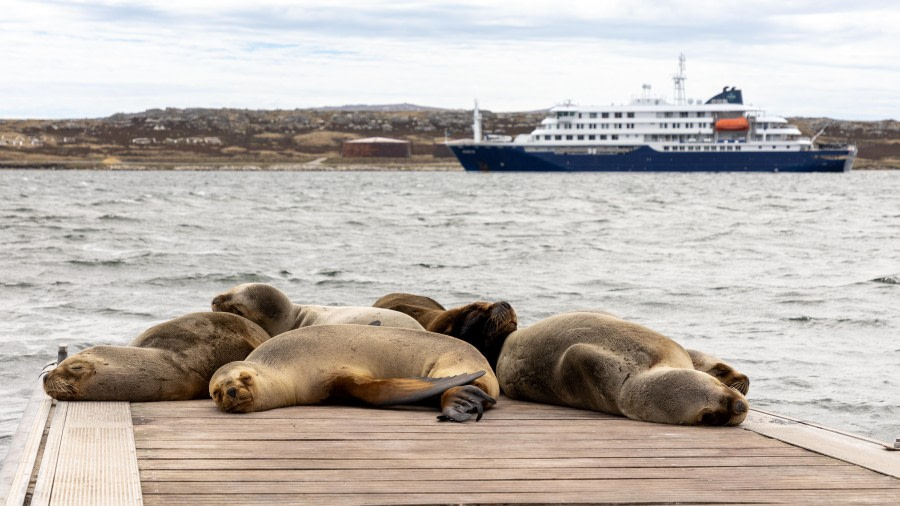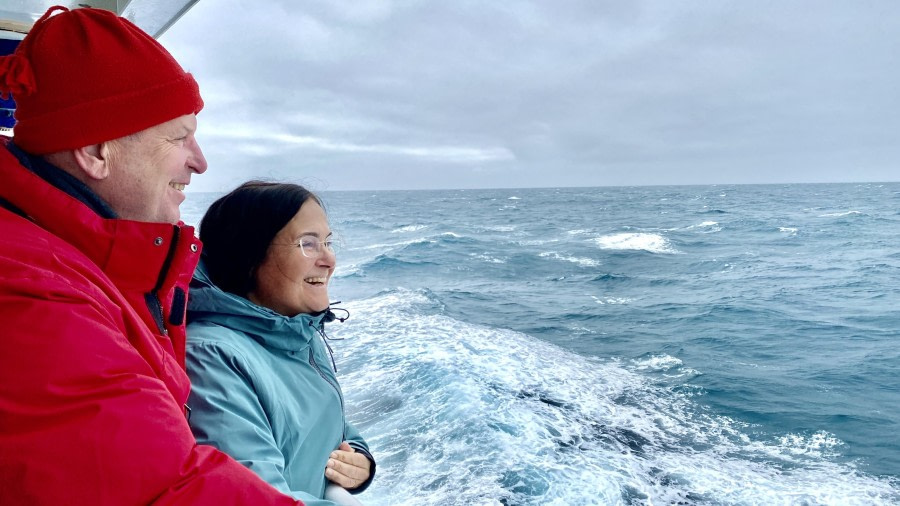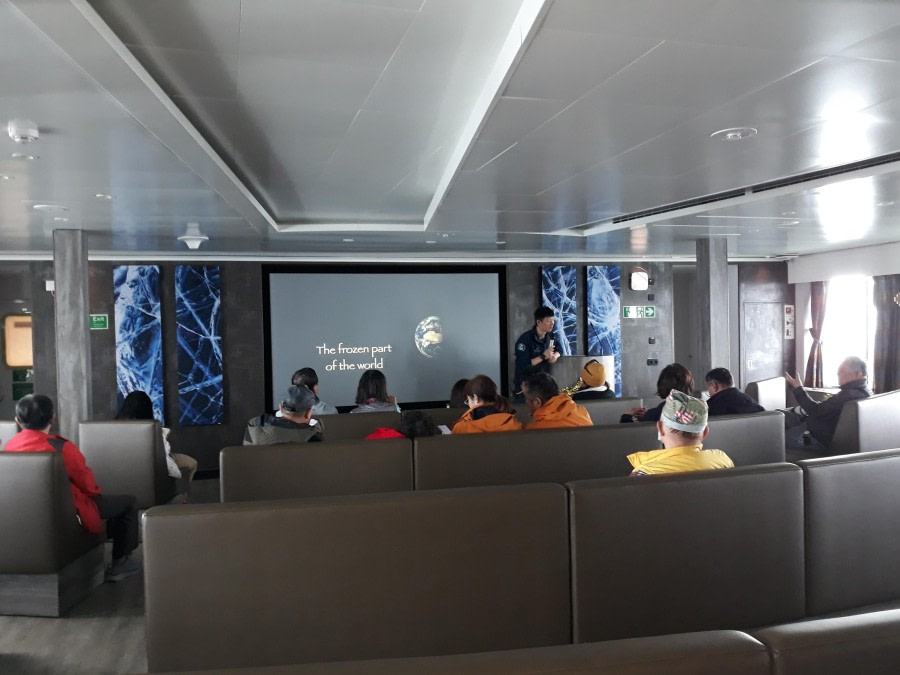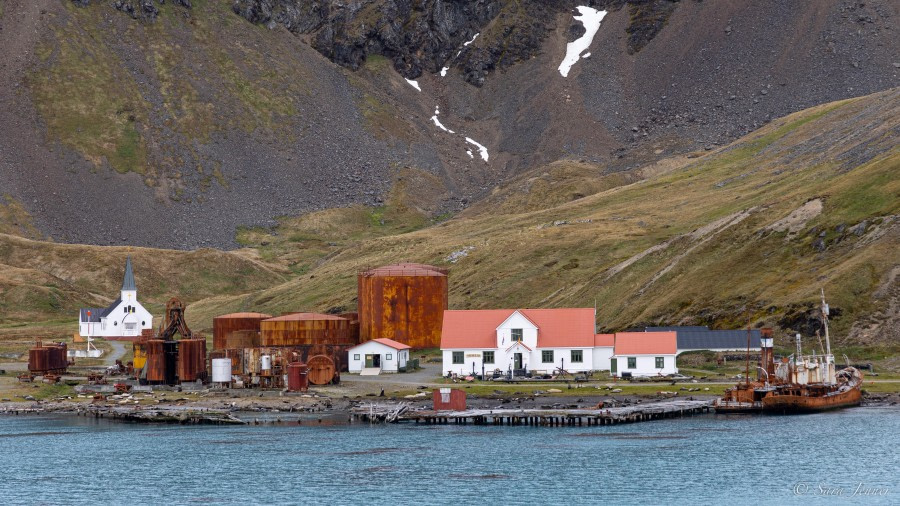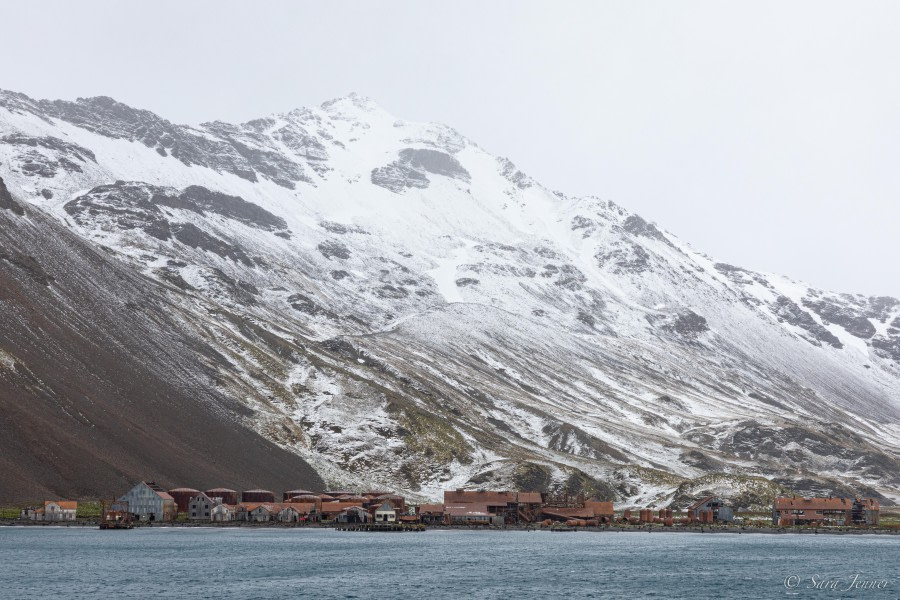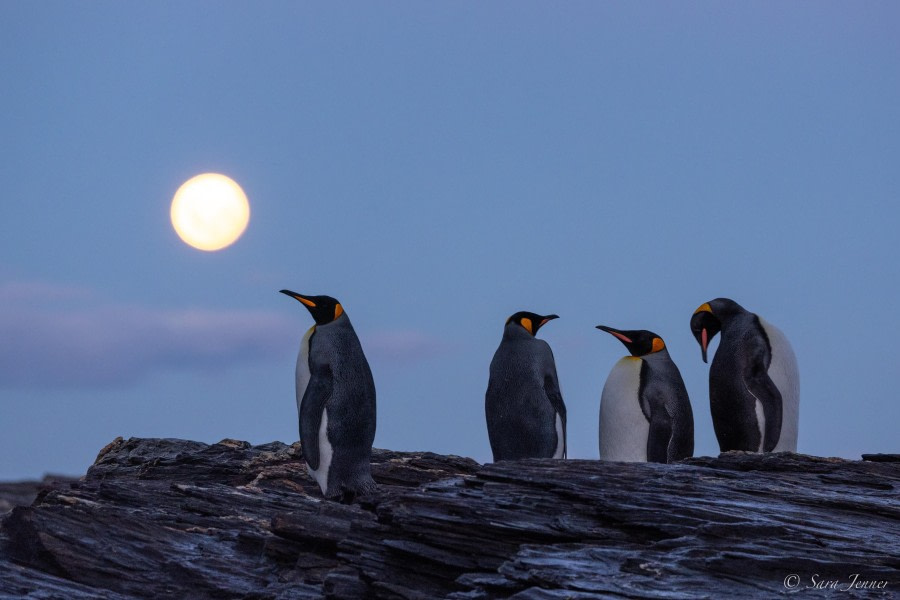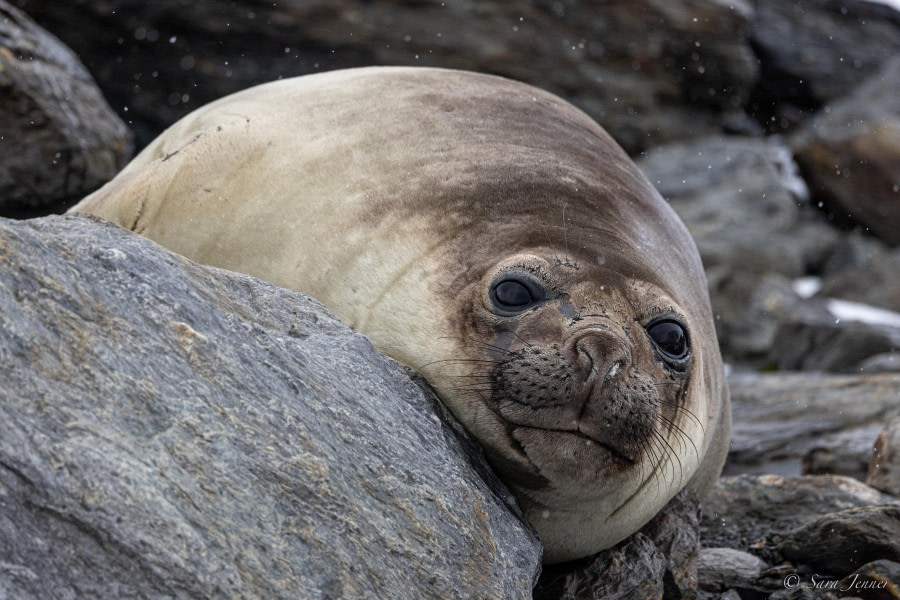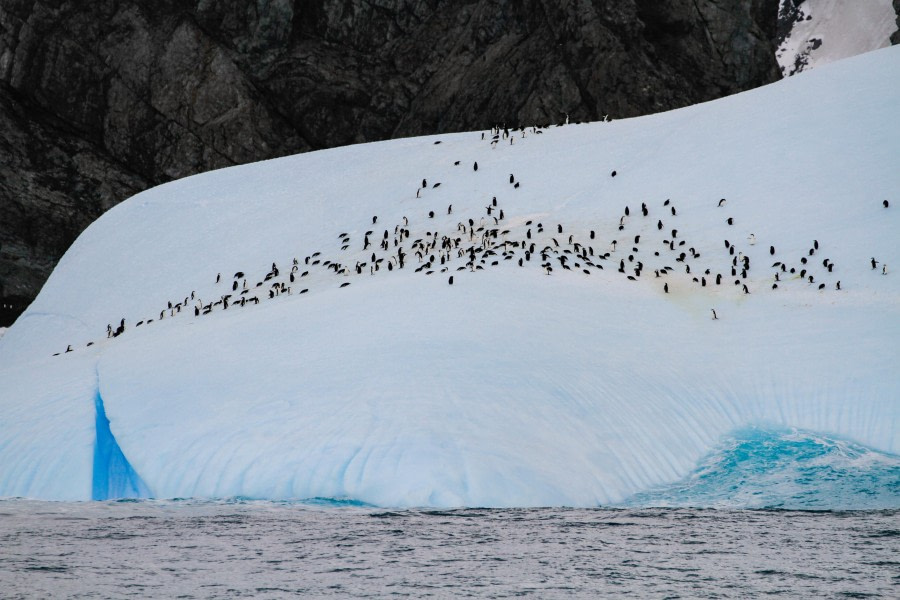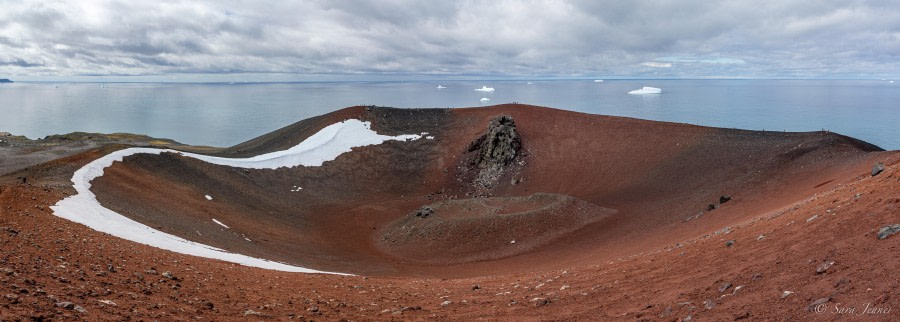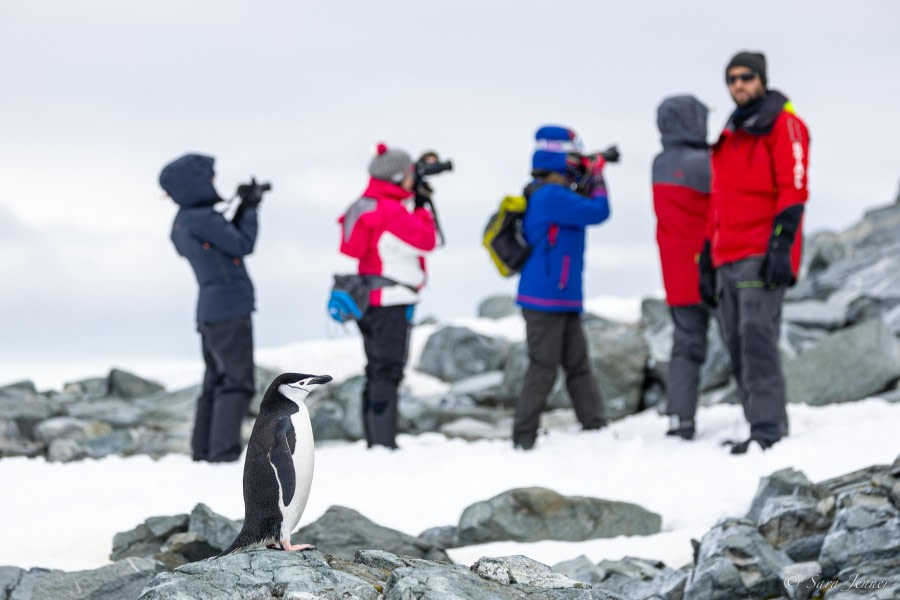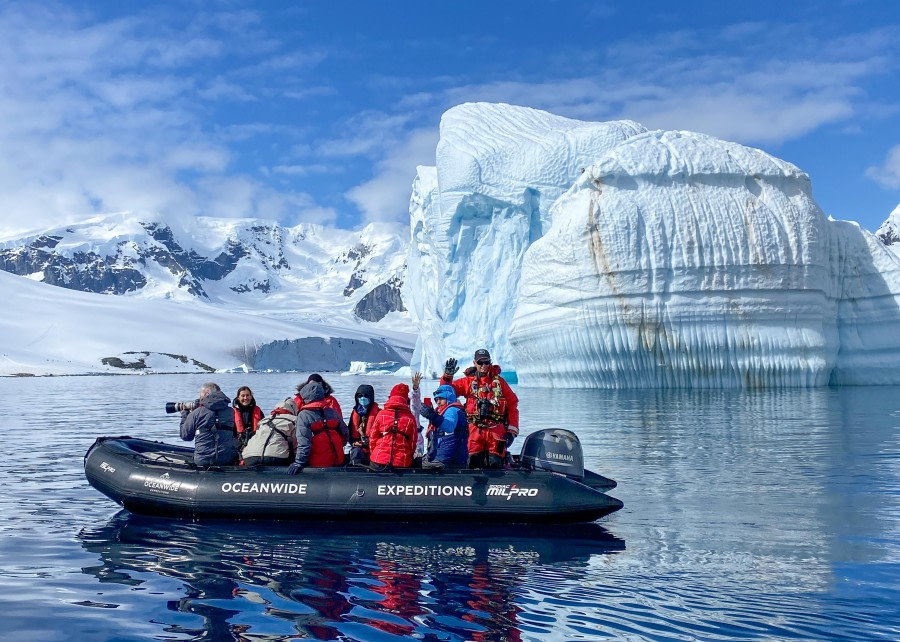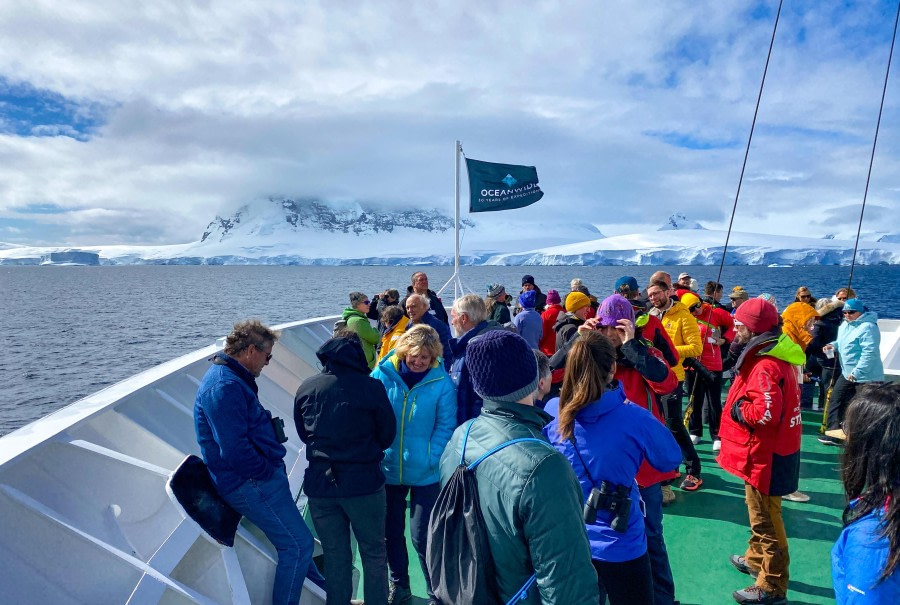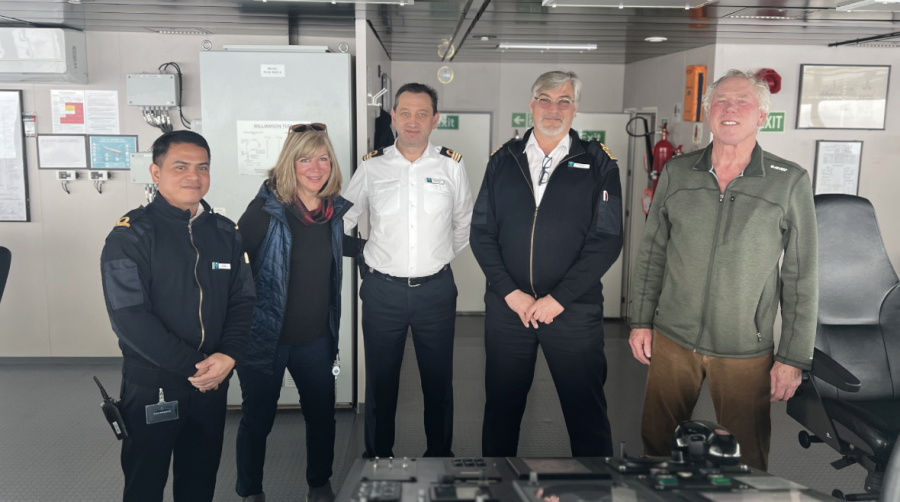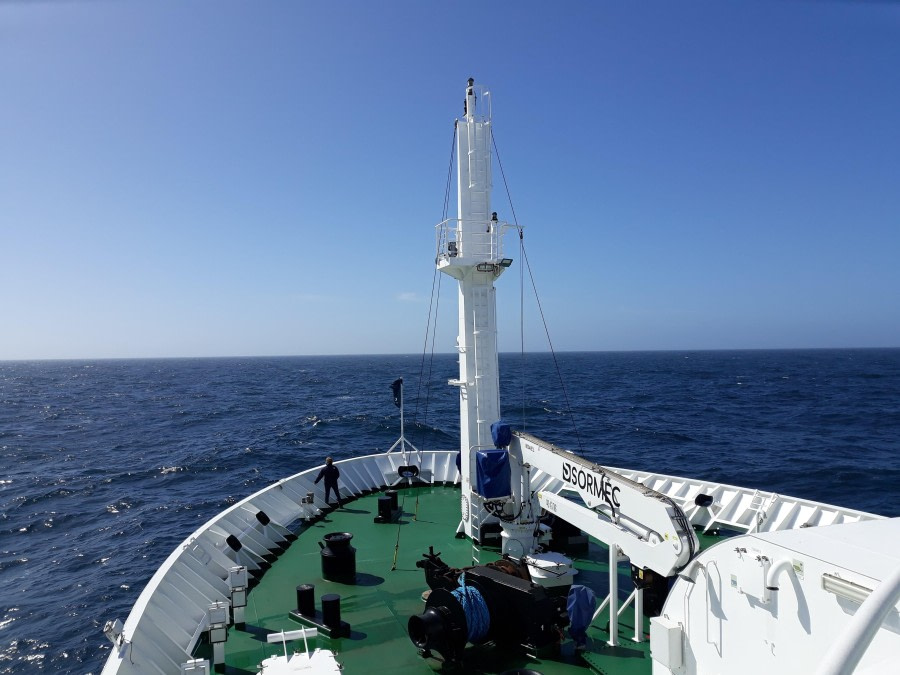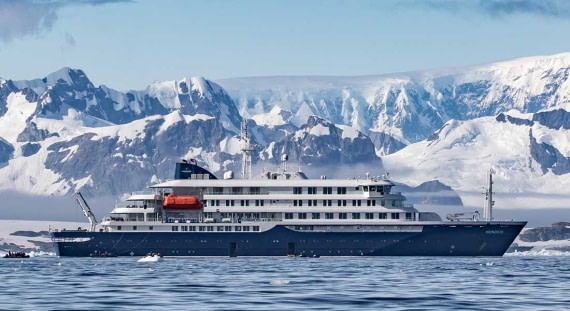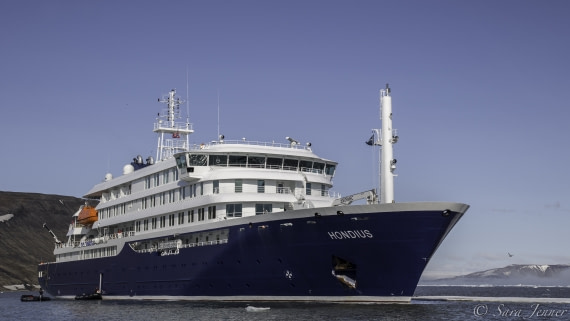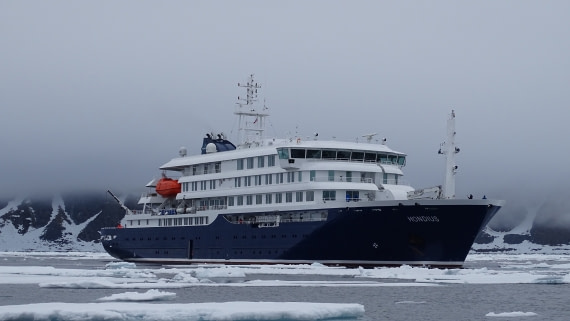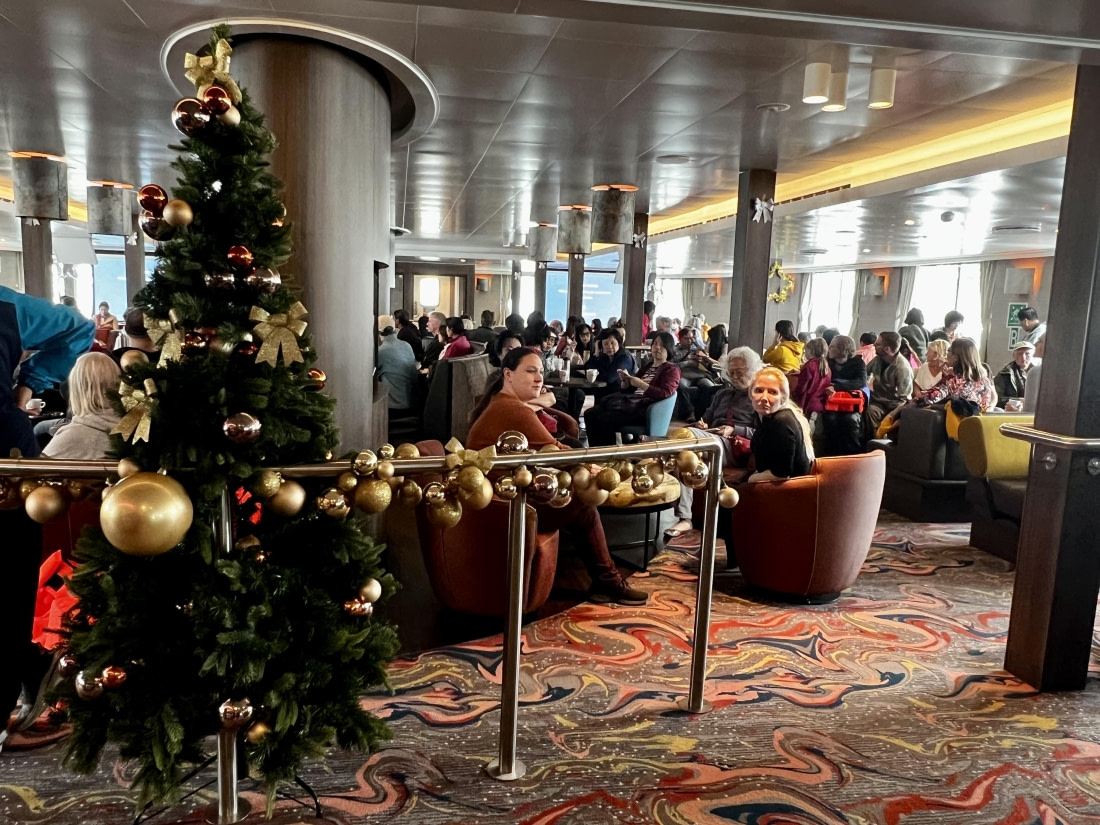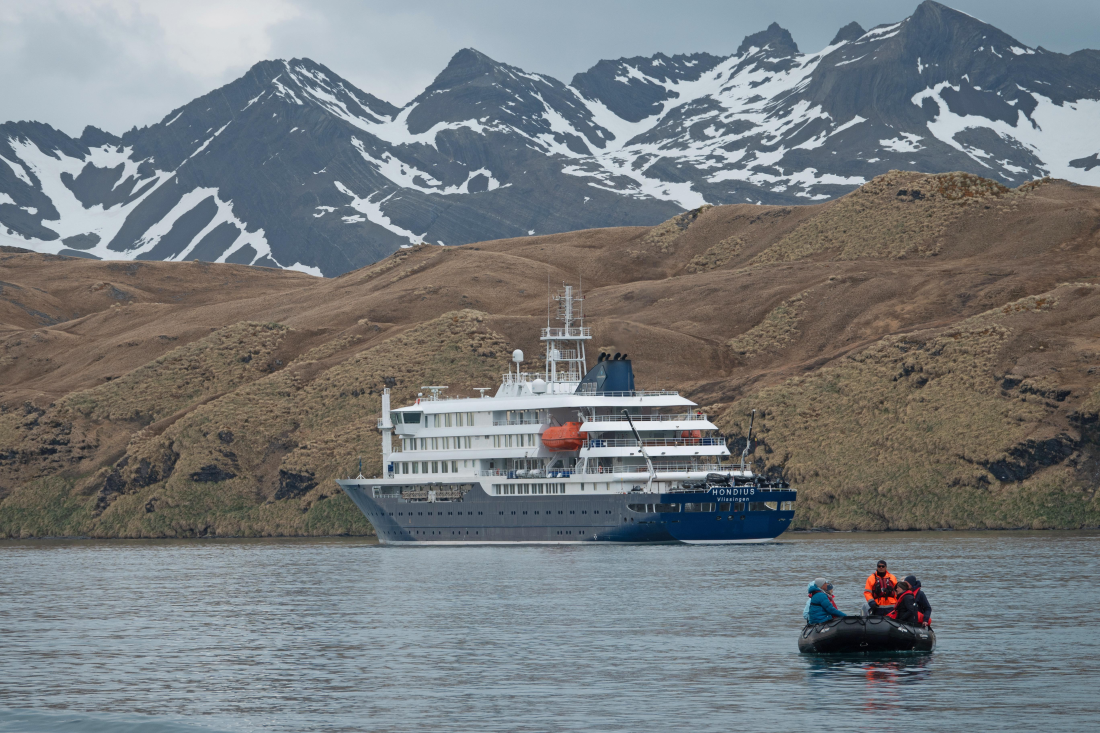| Datum: |
19.12.2023 |
| Position: |
55°20.4’ S / 060°25.0’ W |
| Wind: |
W 4 |
| Wetter: |
Sunny |
| Lufttemperatur: |
+12 |
Sara stood leaning against the dashboard. Through the windows of the captain's bridge, the blurry outlines of approaching land could be discerned. The Hondius ship, gently swaying from side to side and cutting through the waves with its powerful bow, was approaching the Falkland Islands (Malvinas).
The sky was veiled in a light haze, but the strength of the sun breaking through it was enough to make objects cast a faint shadow. The fresh tailwind intermittently caused the waves to foam. The expedition had just begun, and we were still in temperate latitudes, so stepping onto the deck allowed you to feel the wind, strong and quite cool but not yet bone-chilling.
Exactly fifteen minutes before breakfast, at 6:45 am, Sara, whispering, "Well, my friends, let's get it started," approached the microphone, pressed the loudspeaker button, and began her morning speech: "Good morning, good morning, good morning..." During breakfast, many of us felt a slight excitement, as it was our first full expedition day. Two landings were planned for the day: in the morning on the island with the ominous name Carcass Island, and after lunch on another island called Saunders Island. Hondius dropped anchor, sailors lowered several Zodiacs into the water. All members of the expedition team got into these black inflatable motorboats and, taking all the necessary equipment, rushed towards the shore, raising clouds of spray. It turned out to be a routine procedure: first, the expedition team lands, assesses the situation and weather conditions, and then the expedition leader gives the "green light" for us to exchange the ship's iron decks for the solid ground of the land.
We gathered in the Zodiac boarding area and, in small groups of ten, began to board the Zodiacs. As soon as all the seats in the boat were occupied, the Zodiac, led by an experienced guide, set in motion. Quickly gaining speed, it raced towards the shore. The sun played on the waves, the engine roared, splashes flew in all directions, showering us like rain and enhancing the sense of adventure we were experiencing. To those watching us from the deck, the Zodiacs resembled mischievous children who, as soon as the rain stopped, rushed outside and, with their childlike feet, ran through puddles, creating splashes, making adults shake their heads and wag their fingers.
On the shore, Sara, William, Jerry, Jakub, and other members of the expedition team were already waiting for us. The Zodiacs nosed into the white Falkland sand, and one by one, we climbed onto the shore, swinging our legs over the side. The low but feisty waves, as if encouraging us, relentlessly struck the Zodiacs' stern, showering us with sprays and even splashing overboard, causing the Zodiac drivers to grumble and hurry us along.
The sandy beach strip was replaced by tufts of tussock grass as we moved further inland. Sometimes we had to step through marshy areas. The air smelled simultaneously of the sea, grass, and peat — a very unusual combination of natural aromas.
After passing through a densely overgrown grassy hollow, we found ourselves back on the beach but on the other side of the island. It was, I must say, much more picturesque than the one we initially landed on, not only because the sandy strip was much wider but also because the beach was bustling with quite a large number of local fauna representatives.
On a little hill, surveying everything with their proud gaze, stood a family of geese. The male and female, being the same size, sharply differed in the color of their feathers: one was entirely covered in snow-white feathers, and the other had brown feathers, but the chest was speckled in a thin black-and-white stripe. The goslings were all uniformly gray. Treading the ground with their small steps, they constantly bent their heads to the ground, plucking edible vegetation with their sharp beaks.
On the waves, a couple of Steamer ducks swayed. The male had an orange beak, and the female had a green one. These birds had long since forgotten how to fly. Why bother? The climate here is favorable, with no sharp temperature fluctuations, so there's no need to migrate. All their food is right in front of them, no need to fly for it, and the nest is within walking distance, just a few dozen meters from the shoreline. The most amusing thing about Steamer ducks is how they quack. No, it's not quacking; it's more like a cross between the chirping of a cicada and the sounds from some old computer game from the early 90s.
And here are our first penguins — Magellanic penguins! They are quite small, peculiar, constantly waddling and assisting themselves with their wings. Nevertheless, they are completely unbothered by it, strolling along the beach and looking in different directions. Instead of building nests, they dig deep burrows and sit in them, waiting for the arrival of their offspring. Yes, it's dark and dirty, but no skuas will ever steal their eggs. Well, except for the occasional curious penguin chick, wanting to see what lies beyond the burrow, inadvertently emerges on the surface — and here the troubles begin. The malicious skua only needs that, instantly diving down, grabbing the little one, and that's it. It sits somewhere on a rock and pecks at its bloody catch.
Ahead of us was a quite long walk. Three to four kilometers from the landing site stood a hamlet. The locals, the owners of the island, had been living there for a long time, raising sheep and catching fish. Around the houses, there was a garden with flowers and shady coniferous trees. Every time travelers arrived on their island, they baked hundreds of pastries and cakes and treated all the guests. It was the same this time, but before enjoying tea and indulging in local pastries, as mentioned earlier, we had to cover some distance.
The path led along the slope of the hill along the seaside. On our right, sheep were grazing, and local birds fluttered around, while on the left, the bay of Carcass Island spread out, in the middle of which stood our ship Hondius, anchored proudly and confidently. The sun showered us with ultraviolet and warmth, making it hot. Some of us had to make stops to take off sweaters or jackets.
Upon reaching the house, we settled down in the shade of the trees. One by one, we entered the house to grab a pastry or cookie from the table, pour ourselves a cup of tea, and then go back outside, sitting on a bench or a log, appreciating the skill of local confectioners. The morning time quickly passed. Look, and it's already approaching noon! It's time to return to the ship! The Zodiacs were already waiting for us near a small concrete pier. We put on life jackets, boarded the boats, and rushed back on board the Hondius. Pastries are undoubtedly good, but a full lunch is even better!
While we gathered for lunch, the sailors raised the anchor, and our ship headed to our afternoon activity location — the Saunders Island. It was not far away, so we had no more than an hour for post-lunch rest, and even less for our guides. As soon as the anchor chain rattled, the brave participants of our expedition team boarded the Zodiacs and headed to the shore of Saunders Island to make some preparations for our landing. Joyful Commerson's dolphins, thrilled that guests had finally arrived, playfully leaped out of the water, organizing an honorary escort for the Zodiacs all the way to the shore.
Sometime after, the official start of the operation was given. Zodiac after Zodiac, we raced across the smooth water and, as soon as we reached the shore, disembarked, hastily getting rid of the heavy life jackets. White fine sand, the calm of the water, and... penguins! The latter stared at us in complete bewilderment, flapping their peculiar wings and trying to understand who we were and what we wanted.
The local residents, the owners of Saunders Island, arrived in two cars to personally meet and greet us. Parking their cars near the shoreline, they opened their trunks, offering us some interesting souvenir products.
The trail was already marked. A walk of one and a half to two kilometers awaited us along the seaside. Gentoo penguins sat on their nests made of mud and grass, watching over their chicks. The chicks were already quite big, and some of them, gaining courage, went on short walks around their nests. The parents zealously guarded them, clapping and blocking their path with their wings: "Quiet, quiet, stay, where are you going? No, it's too early for you!" It was amusing to watch as they turned their necks toward us, clicked their beaks, as if saying to us: "Move along, guys, we have enough problems here!" And indeed, they had plenty of problems. Nasty skuas constantly circled above, keeping a sharp eye on the penguin colony. God forbid any penguin to be inattentive; instantly, a skua would swoop down and snatch a penguin chick! It would grab it in its beak and carry it away to a place where no penguin had ever returned. Nature here is cruel, but what can you do.
Here is the colony of Magellanic penguins. Like their counterparts we saw in the morning, these also sat in their burrows, consumed by curiosity, peeking outside and looking at us.
On the slope, more appropriately described as a "cliff," a colony of shags was situated, and right next to them, a patch of land was claimed by rockhopper penguins. Small, agile troublemakers, living up to their name, were constantly in motion, hopping from rock to rock. We lingered by them for a long time, taking photos and simply observing their bustle. Nevertheless, the most important awaited us ahead.
Eventually, the trail led us to a colony of black-browed albatrosses. These enormous and majestic birds sat in nests of perfect cylindrical shape. Most of the albatrosses had already raised their offspring. Spotting an albatross chick wasn't an easy task. We had to wait for the parent to rise on its feet, and only then could we see the small gray living bundle beneath it. Some albatross parents allowed their chicks to admire the outside world, holding them snugly under their wings.
Parental duties weighed heavily on the albatrosses. Sitting in their nests, they gazed longingly at the sea, dreaming of the moment when they could finally spread their enormous wings and, taming the wind, soar over the waves into the distance. Albatrosses are made for flight, and only the ancient instinct, as old as the Earth itself, compelled them to sit still in the nest and attend to their offspring. Some albatrosses emitted long, mournful sounds, probably expressing the emotions that had accumulated within them. While preening their chicks' feathers, it seemed as if they were whispering in their ears: "Grow up quickly, and then we'll fly together! I'll show you how the moonlight plays on the sea waves and how whales shoot fountains into the sky. I'll teach you to challenge the wind and catch squids!" Oh, if only it could happen sooner! Our guides showed us where to take the best photographs and made sure none of us, absorbed in the spectacle, fell off the cliff. Albatrosses, glancing at us, furrowed their brows but still posed for photos.
Having feasted our eyes on albatrosses, we started our return journey. On the way back to the landing site, we had the opportunity to turn right and find ourselves on another beach, opposite to the one we arrived on. White, towering waves, ominously roaring, crashed onto the sand. Fearless Magellanic and Gentoo penguins eagerly rushed towards them, disappearing in the white foam. Some penguins, on the contrary, emerged from the sea foam, as if Venus herself, having swum and hunted, appeared in white foam, heading to their nests to swap places with their mates, thereby giving them the opportunity to go hunting in the sea.
But what penguins are standing there near the shoreline? Oh, these are the King penguins! There were only a few of them, some still chicks adorned in huge, clumsy brown pajamas made of soft warm feathers. What a surprise! Of course, we all tried to capture at least a few photographs of these magical creatures.
Walking briskly past the penguins were kelp and dolphin gulls. They turned their heads and repeatedly pecked the sand, devouring the crustaceans hiding in it. Among small sand dunes, oyster catchers strolled, astonishing us with their long bright red bills. Leisurely, rocking from side to side, steamer ducks ambled here and there. A turkey vulture circled above, and, just like at the beginning of our walk, skuas and caracaras soared in the air, striking terror into all the other feathered inhabitants of Saunders Island.
On the slopes of the hill, occasionally drawing attention with loud bleats, sheep grazed. In the local setting, they seemed to perceive us as something outlandish, if not extraterrestrial, certainly as something entirely out of harmony with the surrounding landscape.
One way or another, it was time to return to the ship. As soon as the last of us were on board, the Hondius set course for Stanley, the capital of the Falkland (Malvinas) Islands. In my opinion, a very decent first day of the expedition, wouldn't you agree?
